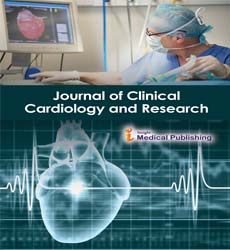Contrast-Enhanced CT in the Diagnosis of Mesenteric Vascular Events Presenting as Small Bowel Obstruction
Simpson Loon
Department of Cardiology, University of New York, New York, NY 10012, USA
Corresponding author:
Simpson Loon,
Department of Cardiology, University of New York, New York, NY 10012, USA;
Email: simpson@loon.ny
Received date: January 01, 2025, Manuscript No. ipccr-25-20606; Editor assigned date: January 03, 2025, PreQC No. ipccr-25-20606 (PQ); Reviewed date: January 15, 2025, QC No. ipccr-25-20606; Revised date: January 22, 2025, Manuscript No. ipccr-25-20606 (R); Published date: January 28, 2025, DOI: 10.36648/.8.1.3
Citation: Loon S (2025) Contrast-Enhanced CT in the Diagnosis of Mesenteric Vascular Events Presenting as Small Bowel Obstruction. J Clin Cardiol Res Vol.8 No.1:3
Introduction
Mesenteric vascular complications, such as ischemia or venous thrombosis, can present with clinical features that closely mimic small bowel obstruction (SBO), posing diagnostic challenges. Accurate differentiation between mechanical obstruction and vascular pathology is essential for timely management and prevention of life-threatening sequelae, including infarction or perforation. Contrast-enhanced Computed Tomography (CECT) has emerged as the gold standard imaging modality in such scenarios due to its ability to simultaneously evaluate bowel morphology, vascular integrity, and perfusion changes. This case report illustrates the diagnostic contribution of CECT in distinguishing SBO from a vascularly related etiology, ultimately guiding patient management [1].
Description
A middle-aged patient presented with acute abdominal pain, recurrent vomiting, abdominal distension, and obstipation. Clinical evaluation suggested bowel obstruction, with diffuse tenderness and tympanic percussion. Initial plain radiographs revealed dilated bowel loops with air-fluid levels, which, while consistent with obstruction, failed to clarify the underlying cause. To delineate the pathology and assess for vascular involvement, contrast-enhanced CT was performed CECT demonstrated dilated proximal small bowel loops with a transition zone in the mid-ileum [2].
Importantly, there was associated mesenteric vessel crowding and subtle venous congestion, findings that raised suspicion of vascular compromise as a contributing factor. Bowel wall enhancement remained preserved, excluding transmural ischemia or necrosis. No pneumatics intestinalis or perforation was identified, further supporting a non-complicated presentation This imaging clarity ruled out neoplastic or hernial causes and helped confirm postoperative adhesion with secondary vascular congestion as the likely etiology The radiological findings informed the treatment pathway [3].
Given the absence of irreversible ischemia, the patient was managed conservatively with nasogastric decompression, intravenous hydration, and hemodynamic stabilization, while being closely monitored for vascular deterioration. Follow-up imaging confirmed resolution of both obstructive and vascular findings. This case underscores the role of CECT not only in localizing obstruction but also in assessing mesenteric circulation, which is critical in cardiology-related abdominal vascular pathology the integration of imaging with clinical monitoring allowed for timely adjustment of therapeutic strategies, preventing unnecessary surgical intervention while safeguarding against potential ischemic progression [4].
The patient’s recovery highlighted the importance of a multidisciplinary approach, where radiology, gastroenterology, and cardiology collaboratively interpret findings to optimize outcomes. By combining anatomical delineation with functional assessment, CECT provided a comprehensive evaluation that guided conservative management and ensured patient safety. This case emphasizes how advanced imaging, when applied within a cardiocentric framework, extends beyond diagnosis to become a cornerstone in individualized treatment planning and long-term vascular risk reduction [5].
Conclusion
This case highlights the indispensable role of contrast-enhanced CT in differentiating small bowel obstruction from vascular complications involving the mesenteric circulation. By simultaneously assessing bowel and vascular integrity, CECT provides a comprehensive diagnostic approach that supports precise management decisions. Early imaging ensures appropriate conservative versus surgical intervention, prevents ischemic progression, and emphasizes the importance of radiology in managing cardiology-related abdominal emergencies.
References
- Fernández-Alfonso MS, Gil-Ortega M, Aranguez I, Souza D, Dreifaldt M, et al. (2017) Role of PVAT in coronary atherosclerosis and vein graft patency: Friend or foe? Br J Pharmacol 174: 3561–3572
Google Scholar Cross Ref Indexed at
- BeÅ?towski J (2012) Leptin and the regulation of endothelial function in physiological and pathological conditions. Clin Exp Pharmacol Physiol 39: 168–178
Google Scholar Cross Ref Indexed at
- Boydens C, Maenhaut N, Pauwels B, Decaluwé K, Van de Voorde J (2012) Adipose tissue as regulator of vascular tone. Curr Hypertens Rep 14: 270–278
Google Scholar Cross Ref Indexed at
- Queiroz M, Sena CM (2024) Perivascular adipose tissue: A central player in the triad of diabetes, obesity, and cardiovascular health. Cardiovasc Diabetol 23: 455
Google Scholar Cross Ref Indexed at
- Pellegrinelli V, Carobbio S, Vidal-Puig A (2016) Adipose tissue plasticity: How fat depots respond differently to pathophysiological cues. Diabetologia 59: 1075–1088
Open Access Journals
- Aquaculture & Veterinary Science
- Chemistry & Chemical Sciences
- Clinical Sciences
- Engineering
- General Science
- Genetics & Molecular Biology
- Health Care & Nursing
- Immunology & Microbiology
- Materials Science
- Mathematics & Physics
- Medical Sciences
- Neurology & Psychiatry
- Oncology & Cancer Science
- Pharmaceutical Sciences
